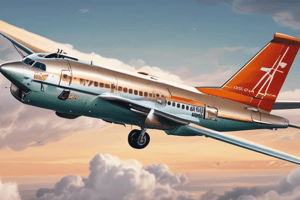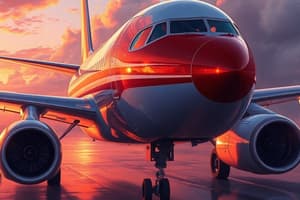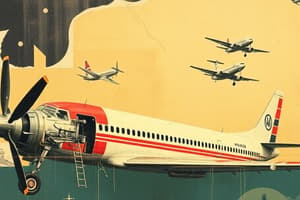Podcast
Questions and Answers
What is the aerodynamic force caused by air flowing over an aerofoil?
What is the aerodynamic force caused by air flowing over an aerofoil?
Lift
What force opposes thrust and is caused by airflow disruption or impact on an aerofoil?
What force opposes thrust and is caused by airflow disruption or impact on an aerofoil?
Drag
Which force forms the basis of momentum theory for propellers and is felt on the blade face?
Which force forms the basis of momentum theory for propellers and is felt on the blade face?
Thrust
What angle is termed the angle between the chord line and the plane of rotation?
What angle is termed the angle between the chord line and the plane of rotation?
In a Sensenich propeller designated M74DMS5-2-60, what does the '74' component indicate?
In a Sensenich propeller designated M74DMS5-2-60, what does the '74' component indicate?
What angle is termed as the angle between the chord line and the angle of relative wind/airflow?
What angle is termed as the angle between the chord line and the angle of relative wind/airflow?
To ensure all sections of the propeller blade produce equal thrust, how is the blade manufactured?
To ensure all sections of the propeller blade produce equal thrust, how is the blade manufactured?
What is pitch in relation to propellers?
What is pitch in relation to propellers?
Slip is defined as the sum of geometric pitch and effective pitch.
Slip is defined as the sum of geometric pitch and effective pitch.
What effect does propeller torque have on an aircraft structure if the propeller is being driven anti-clockwise?
What effect does propeller torque have on an aircraft structure if the propeller is being driven anti-clockwise?
What effect does fitting a contra-rotating propeller have?
What effect does fitting a contra-rotating propeller have?
Which force tends to rotate propeller blades toward a fine blade angle on variable pitch propellers?
Which force tends to rotate propeller blades toward a fine blade angle on variable pitch propellers?
What force is a resultant force from the load that air resistance (drag) places on the blades and bends the propeller blades opposite to the direction of rotation?
What force is a resultant force from the load that air resistance (drag) places on the blades and bends the propeller blades opposite to the direction of rotation?
Which part of the propeller blade is the cylindrical part near the blade root that contributes little to thrust?
Which part of the propeller blade is the cylindrical part near the blade root that contributes little to thrust?
What is the name of the part designed to restore the round section of the blade shank to an aerofoil shape?
What is the name of the part designed to restore the round section of the blade shank to an aerofoil shape?
What imperfections should timber be free from when used laminating a wooden propeller?
What imperfections should timber be free from when used laminating a wooden propeller?
What material is NOT used for leading-edge sheathing?
What material is NOT used for leading-edge sheathing?
What may excess propeller vibration cause?
What may excess propeller vibration cause?
What describes a Fixed-Pitch propeller?
What describes a Fixed-Pitch propeller?
What are contra-rotating propellers?
What are contra-rotating propellers?
What is the purpose of feathering a propeller?
What is the purpose of feathering a propeller?
Once reverse has been selected in the cockpit, what happens to the propeller blades?
Once reverse has been selected in the cockpit, what happens to the propeller blades?
Why is Torque Sensing System fitted to propellers?
Why is Torque Sensing System fitted to propellers?
What does use of a 'skull cap spinner' achieve
What does use of a 'skull cap spinner' achieve
Flashcards
Lift (Propeller)
Lift (Propeller)
Aerodynamic force from air flowing over an airfoil, increasing velocity and decreasing pressure above.
Drag (Propeller)
Drag (Propeller)
Force opposing thrust, caused by airflow disruption over an airfoil.
Thrust (Propeller)
Thrust (Propeller)
Forward-acting force created by accelerating air rearwards.
Total Reaction
Total Reaction
Signup and view all the flashcards
Blade Angle
Blade Angle
Signup and view all the flashcards
Angle of Attack
Angle of Attack
Signup and view all the flashcards
Blade Twist
Blade Twist
Signup and view all the flashcards
Pitch
Pitch
Signup and view all the flashcards
Propeller Slip
Propeller Slip
Signup and view all the flashcards
Propeller Torque
Propeller Torque
Signup and view all the flashcards
Gyroscopic Effect
Gyroscopic Effect
Signup and view all the flashcards
Propeller Slipstream
Propeller Slipstream
Signup and view all the flashcards
Contra-Rotating Propellers
Contra-Rotating Propellers
Signup and view all the flashcards
Centrifugal Force
Centrifugal Force
Signup and view all the flashcards
Centrifugal Twisting Moment (CTM)
Centrifugal Twisting Moment (CTM)
Signup and view all the flashcards
Aerodynamic Twisting Moment (ATM)
Aerodynamic Twisting Moment (ATM)
Signup and view all the flashcards
Torque Bending Force
Torque Bending Force
Signup and view all the flashcards
Thrust Bending Force
Thrust Bending Force
Signup and view all the flashcards
Leading Edge
Leading Edge
Signup and view all the flashcards
Trailing Edge
Trailing Edge
Signup and view all the flashcards
Blade Back
Blade Back
Signup and view all the flashcards
Blade Face
Blade Face
Signup and view all the flashcards
Chord Line
Chord Line
Signup and view all the flashcards
Blade Stations
Blade Stations
Signup and view all the flashcards
Hub Assembly
Hub Assembly
Signup and view all the flashcards
Blade Root (Butt)
Blade Root (Butt)
Signup and view all the flashcards
Blade Shank
Blade Shank
Signup and view all the flashcards
Blade
Blade
Signup and view all the flashcards
Blade Tip
Blade Tip
Signup and view all the flashcards
Propeller Mounting
Propeller Mounting
Signup and view all the flashcards
Study Notes
Knowledge Levels
- Basic knowledge is indicated by knowledge level indicators 1,2, or 3, for categories A, B1, and B2 aircraft maintenance licenses.
- Category C applicants must meet either the B1 or B2 basic knowledge levels.
Knowledge Level 1
- Applicant should be familiar with the basic elements of the subject.
- Applicant should be able to give a simple description using common words and examples.
- Applicant should be able to use typical terms.
Knowledge Level 2
- Applicant should have general knowledge of theoretical and practical aspects and apply that knowledge.
- Applicant should be able to understand the theoretical fundamentals of the subject.
- Applicant should be able to give a general description, using typical examples as appropriate.
- Applicant should be able to use mathematical formulae in conjunction with physical laws describing the subject.
- Applicant should be able to read and understand sketches, drawings, and schematics.
- Applicant should be able to apply knowledge practically using detailed procedures.
Knowledge Level 3
- Applicant should have detailed theoretical and practical knowledge and combine elements logically.
- Applicant should know the theory and interrelationships with other subjects.
- Applicant should be able to give a detailed description using theoretical fundamentals and specific examples.
- Applicant should understand and be able to use mathematical formulae related to the subject.
- Applicant should be able to read, understand, and prepare sketches, simple drawings, and schematics.
- Applicant should be able to apply knowledge practically using manufacturer's instructions.
- Applicant should be able to interpret results from various sources and apply corrective action.
Propeller Fundamentals I (17.1) Learning Objectives
- Describe propeller blade element theory (Level 2).
- Describe propeller high and low blade angle (Level 2).
- Describe propeller reverse angle (Level 2).
- Describe propeller angle of attack (Level 2).
- Describe propeller rotational speed (Level 2).
- Describe propeller slip (Level 2).
Propeller Forces - Lift
- Lift is an aerodynamic force caused by air flowing over an aerofoil.
- Cambered surface increases airflow velocity and decreases pressure above aerofoil.
- Higher pressure below and decreased pressure above produces upward force, or lift.
- Lift, with propellers forms the basis of blade element theory.
- Blade element is any randomly selected area of the blade aerofoil.
Propeller Forces - Drag
- Drag is a force opposing thrust.
- It is caused by the disruption or impact of airflow over/onto an aerofoil.
Propeller Forces - Thrust
- Thrust is a forward-acting force.
- It is the reaction to the mass of air being accelerated rearwards.
- Thrust is felt on the blade face and forms the basis of momentum theory for propellers (Newton's Third Law of Motion).
- Momentum measures a moving body's motion as a mass and velocity product.
Total Reaction
- A blade's total reaction is the resultant of: Lift and drag, Thrust and torque
- Vectors for lift/drag, thrust/torque are plotted to derive total reaction because the propeller is a rotating wing.
- Both force pairs act on the blade simultaneously.
Increase in Rotational Speed
- An increase in rotational speed will increase lift and drag forces equally.
- Rotational speed is restricted, blade tip speed must remain below the speed of sound.
Effects on Propeller Thrust - Blade Angle
- Plane (path) is the plane in which the propeller is rotating.
- Blade Angle is the angle between the chord line and the plane of rotation, usually measured in degrees.
Blade Angle Measurement
- Blade angle is measured with reference to a datum point, similar to aircraft stations.
- Reference point is necessary due to blade angle decreasing from root to tip.
- Datum point, generally 75% of propeller radius from hub center.
- Aircraft Maintenance Manual (AMM) and Aircraft Type Certificate give definitive angles and positions
- For example: Sensenich propeller M74DMS5-2–60, "74" indicates 74-in diameter, "–60" indicates 60-in pitch at 75% station
Angle of Attack
- Angle of attack is the angle between the chord line and the angle of relative wind/airflow.
- For best results, this should be 2° to 4°.
- Within this angle of attack, incomding air is compressed and allowed to expand as it leaves the blade's trailing edge, resulting in thrust.
- Angle of attack combines two airflows: True Air Speed (TAS) and propeller revolutions per minute (rpm).
Blade Twist
- Section moves faster further from the hub along the propeller blade.
- To ensure equal thrust: blade manufactured with gradual twist from hub to tip.
- Gradual twist, blade angle decreases towards tip, ensures 2° to 4° angle of attack along blade.
- If the propeller tip reaches the speed of sound, the shockwaves produced cause vibration and prevent the tip from producing thrust.
Pitch
- It is the distance moved forward by the propeller in one revolution
- This can vary with different blade angles on variable pitch propellers
Propeller Slip
- The difference between geometric pitch and effective pitch.
- Geometric pitch: calculated distance propeller advances forward through solid medium in one revolution.
- Effective pitch: distance propeller actually advances forward in one revolution due to moving through air.
- Example 50-in geometric pitch propeller moves forward only 35 in. per revolution in air, slip is 15 in. a 30% loss, propeller is 70% efficient.
- Most propellers are 75% to 85% efficient.
Propeller Fundamentals II (17.1) Learning Objectives
- Describe propeller aerodynamic forces (Level 2).
- Describe propeller centrifugal forces (Level 2).
- Describe propeller thrust forces (Level 2).
- Describe propeller torque (Level 2).
- Describe relative airflow effect on propeller blade angle of attack (Level 2).
- Describe propeller vibration and resonance (Level 2).
Effects on Aircraft Stability - Propeller Torque
- If a propeller is being driven anticlockwise, the torque that is being developed to drive the propeller has an effect on the aircraft structure and will tend to roll the aircraft clockwise.
Propeller Gyroscopic Effect and Slipstream
- Gyroscopic effect is spinning a bicycle wheel while holding the axle, then trying to tilt the axle. It actually tilts at 90° in the direction intended.
- A rotating body (propeller) resists any change in its plane of rotation, in straight and level flight, the propeller resists a turn.
- Any change gives a tendency change in a direction at right angles (90°) to the force.
- Rotating propeller imparts rotational motion to the slipstream in the same direction as propeller, has adverse effect on aircraft's fin.
- Airflows represented by solid and dotted lines. The solid curls over top and the dotted initially curls under until it reaches trailing edge.
- Force acting on tail causes aircraft to turn right.
Contra-Rotating Effect
- The fitment of a contra-rotating propeller eliminates propeller torque, propeller slipstream, and propeller gyroscopic effect.
- Second propeller straightens first one's slipstream,straight high-speed air over fin, improves control.
- Propeller torque is canceled because propellers spin in opposite directions, neutralising the gyroscopic effect.
Forces Acting on a Propeller
- As propeller is rotating, certain forces act upon it: centrifugal, Centrifugal Twisting Moment (CTM), aerodynamic Twisting Moment (ATM), bending forces, thrust and drag.
Centrifugal Force
- Centrifugal force tends to throw the rotating propeller blades away from the propeller hub.
- Mounts to many thousands of newtons.
Centrifugal Twisting Moment (CTM)
- Is a force which tends to rotate propeller blades toward a fine blade angle on variable pitch ones.
- This results from propeller mass, located in front of rotational axis, aligning with plane of rotation.
- CTM will always be a greater force than ATM; manufacturers use it to alter blade angle from coarse to fine.
Aerodynamic Twisting Moment (ATM)
- Is a force that tries to move the propeller blades to a coarser blade angle.
- The center of pressure is in front of the rotational axis of the blade, this forces the blades to rotate in one direction
- This force tends to increases the blade angle.
- Some propeller designs use this force to aid in feathering.
Bending Forces
- Bending force is divided into torque bending force (caused by drag) and thrust bending force (caused by thrust).
- Torque bending force is load that air resistance (drag) places on the blades.
- Bends propeller blades opposite from rotation direction. Thrust bending force blades bends forward aircraft pulled though air.
Force Coupling
- Couple of centrifugal and thrust forces creates severe stresses, greater near hub.
- Blade face exposed to tension from centrifugal force and bending.
- Therefore, propeller must able to withstand these stresses: they increase proportionally with rpm.
- Simple blade scratch/dent can have severe repercussions.
Propeller Angle of Attack
- Understand how propeller's performance varies, must understand vectors: line is drawn to scale, shows velocity/ force.
- Fixed-pitch's performance (thrust) varies affected by rotational velocity (rpm) and aircraft velocity (TAS in kt).
- Propeller designed to 2° to 4° angle-of-attack at: 1500 rpm/50 kt forward will gives needed thrust, and then rotatational velocity or forward velocity will alter.
Increased Rotational Velocity
- Maintaining forward velocity but increasing rotational, the angle of attack has increased.
Increased Forward Velocity
- Increased forward velocity maintained rotational velocity, relative airflow has decreased the attack angle.
- Rotating blades may negative attack angle: no forward thrust; propeller acts like a brake.
- Changing rotational or aircraft alters propellers angle of attack, varying it outside lowered efficiency due to designed parameters.
Efficient Blade Tip Speed
- Larger propellers were developed engine power absorption.
- Increase in propeller diameter didn't necessarily increase efficiency, larger propels lost performance.
- Tip vibration or flutter is caused by shock waves because tip approaches speed of sound.
- Approximately 1200 ft/s( or 660 kt) at sea level on a standard day of 15 °C: it was necessary to keep blade tip speed below speed of sound. Blade Tip speed needs to remain below the speed of sound however increase the number of blades or blade shape/section absorption rate.
Blade Vibration
- Blade vibration exerted on spinning and is blade vibration.
- Aerodynamic forces bend the propeller blades forward at the time of vibration and buffeting.
- Mechanical vibrations are in piston engine power pulses Mechanical more disruptive v aerodynamic, standing wave patterns occur propeller blades and structural failure. Vibrational stresses detrimental point on blade, critical location 6 in. blade tips. Many airframe-engine-propeller combinations eliminated detrimental effects of vibrational stresses through careful design engine propeller combinations have critical range. Severe propeller vibration red arc indicator. Engine operation in critical range limited passage rpm setting.
Studying That Suits You
Use AI to generate personalized quizzes and flashcards to suit your learning preferences.



